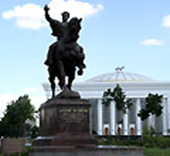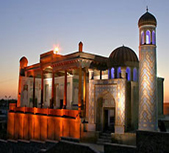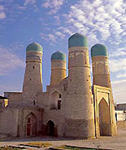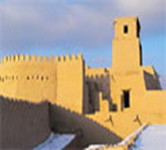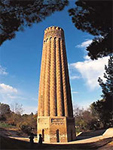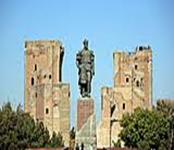|
Категории
|
Shahrisabz
Shakhrisabz was founded over 2,700 years ago. The ancient inhabitants of the city - the Sogdians were known for its handicrafts, commerce and high culture. The city in ancient times was called the cache. In 329 BC the city was captured by the troops of Alexander the Great. Since that time, Cash was under the influence of Hellenistic culture. There were some spread Greek cults and beliefs. The most prominent were the cults of Heracles, Dionysus and Athena.
In IV-V centuries AD Cash was a member of the nomads Chionites and Kidarits. In the VI century it became part of the State of Ephtalites. In the years 567-658 Sogdian rulers of the city submitted to the Turks. In the VIII century the city was conquered by the Arabs for a long time been a center of anti-Arab resistance. One of the last Sogdian rulers of Shakhrisabz was Bobo Beck. Shakhrisabz known as the birthplace of Amir Timur (Tamerlane). Timur was born in the Khoja Ilgar village on the outskirts of Shahrisabz. In the XIV - XV centuries was the beginning of his residence. By order of Timur in Shakhrisabz was built the magnificent Ak-Saray palace.
In the XVI-XVIII centuries Shahrisabz was a member of the Bukhara Khanate. In the middle of the XVIII century the Uzbek clan Kenagas founded a semi-independent possession, which maintained its relative autonomy until the Russian conquest in 1869. The historic city center is included in the list of UNESCO World Heritage site.
|
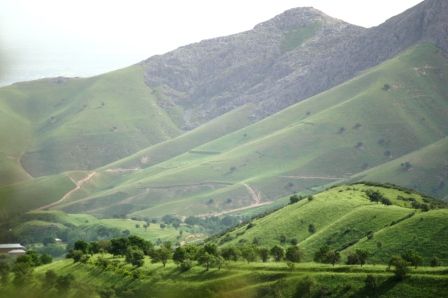 Shahrisabz
Shahrisabz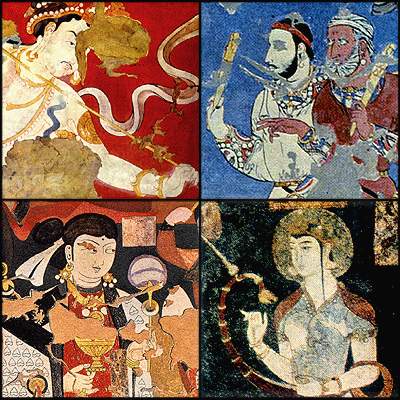 In I-III centuries BC the city was in an orbit of influence of the Kushan Empire.
In I-III centuries BC the city was in an orbit of influence of the Kushan Empire.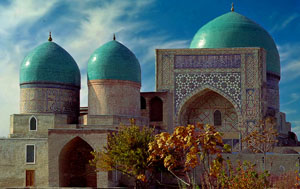 In the town are buried some in the Timurid dynasty: Timur’s father - Muhammad Taragai, two eldest sons of Tamerlane - Jahangir and Umar Sheikh.
In the town are buried some in the Timurid dynasty: Timur’s father - Muhammad Taragai, two eldest sons of Tamerlane - Jahangir and Umar Sheikh.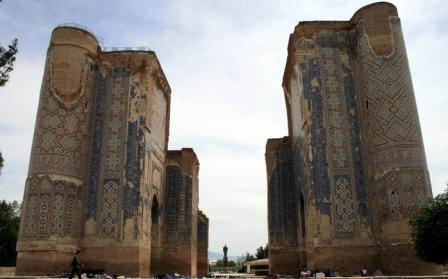 In the Shakhrisabz remained not so many historical monuments, but they are unique or have tremendous historical value. The most famous landmark of Shakhrisabz - a Timur's Ak-Saray palace ("White Palace», XIV-XV). Come down to us in a very ruined state, Dor-us Saodat complex ("Place of Power", XIV-XVI), where the tomb of the sons of Temur - Jahangir and Umar, Dor-ut Tilovat complex ("Place of reflection, contemplation", XIV) - the mausoleum of Timur's spiritual leader - Sheikh Shamsiddin Kulol, where is also buried Timur’s father - Amir Taragai, Gumbazi Saiydon (XV c.) - Mausoleum (makbarat) of descendants of Ulugbek, Kok Gumbaz Mosque (XV c.).
In the Shakhrisabz remained not so many historical monuments, but they are unique or have tremendous historical value. The most famous landmark of Shakhrisabz - a Timur's Ak-Saray palace ("White Palace», XIV-XV). Come down to us in a very ruined state, Dor-us Saodat complex ("Place of Power", XIV-XVI), where the tomb of the sons of Temur - Jahangir and Umar, Dor-ut Tilovat complex ("Place of reflection, contemplation", XIV) - the mausoleum of Timur's spiritual leader - Sheikh Shamsiddin Kulol, where is also buried Timur’s father - Amir Taragai, Gumbazi Saiydon (XV c.) - Mausoleum (makbarat) of descendants of Ulugbek, Kok Gumbaz Mosque (XV c.).